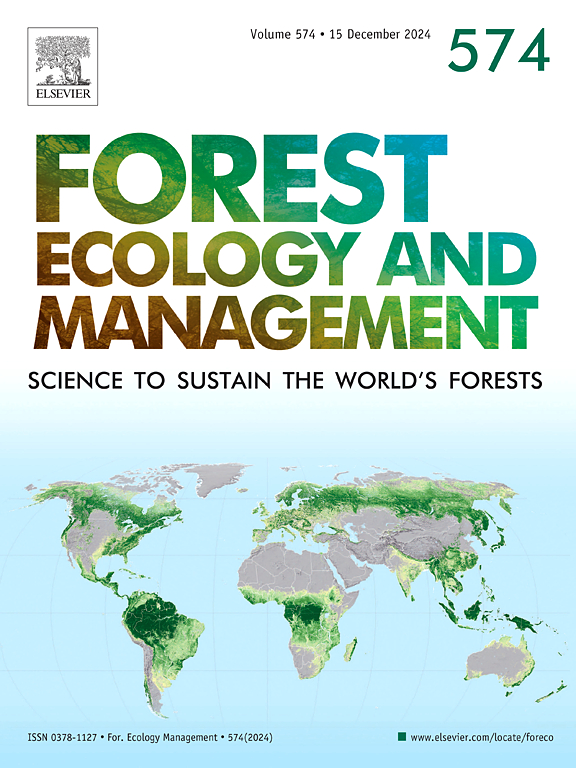施用尿素和石灰对道格拉斯冷杉林强化有机质去除和植被控制后土壤养分动态的影响
IF 3.7
2区 农林科学
Q1 FORESTRY
引用次数: 0
摘要
美国西澳沿海的Fall River长期土壤生产力站点研究了有机物去除和植被控制对道格拉斯冷杉(pseudosuga menziesii var. menziesii (Mirbel) Franco)生产力的长期影响。处理包括全洞(BO)、全树(WT)和全树去除粗木屑(WT+),其中5年完全植被控制(V: BOV、WTV、WT+V)或仅初始控制(BO)。已有研究表明,福尔河土壤在初始阶段含有高全氮和低碱阳离子,BOV、WTV和WT+V处理在18年后降低了土壤NO3、Ca、K和Mg的有效性。在2年和5年的时间里,通过土壤提取和植物根系模拟器(PRS)探针,研究了尿素施肥和石灰化是否能恢复养分损失。尿素快速提高硝态氮有效性至50 cm,但WT+V地块反应最小。尿素在初始阶段也提高了PRS Ca、Mg、Fe、Mn、Zn和Cu,但随后降低了PRS Ca和Mg的供应速率和土壤ph。在森林地面和浅层土壤中,施用石灰提高了交换性Ca和PRS Ca,但在WT+V钙含量最低的20-50 cm处没有提高。虽然本研究使用了非经营性植被控制和有机物清除,但它强调了林下植被和收获残留物在保持土壤养分方面的作用,以及肥料改善养分损失的潜力。本研究还提出了尿素对高氮低碱阳离子土壤中碱阳离子淋溶的影响,这可以解释在类似的沿海土壤中观察到的低肥料生长响应。本文章由计算机程序翻译,如有差异,请以英文原文为准。
Effects of urea fertilization and liming on soil nutrient dynamics following intensive organic matter removal and vegetation control in a Douglas-fir forest
The Fall River Long-Term Soil Productivity site in coastal WA, USA, examines the long-term effects of organic matter removal and vegetation control on Douglas-fir (Pseudotsuga menziesii var. menziesii (Mirbel) Franco) productivity. Treatments included bole-only (BO), whole-tree (WT), and whole-tree with coarse woody debris removal (WT+), with either five years of complete vegetation control (V: BOV, WTV, WT+V) or only initial control (BO). Previous studies showed that the Fall River soil initially contained high total N and low base cations, and BOV, WTV, and WT+V treatments had reduced soil NO3, Ca, K, and Mg availability after 18 years. This study tested whether urea fertilization or liming could restore nutrient losses using soil extractions and Plant Root Simulator (PRS) probes over 2 and 5 years. Urea fertilization quickly increased NO3 availability down to 50 cm, though WT+V plots responded the least. Urea also boosted PRS Ca, Mg, Fe, Mn, Zn, and Cu initially but subsequently reduced PRS Ca and Mg supply rates and soil pH. Liming raised exchangeable Ca and PRS Ca in the forest floor and shallow soil, but not at 20–50 cm where WT+V had the lowest Ca levels. While this study used non-operational vegetation control and organic matter removals, it underscores the role of understory vegetation and harvest residues in retaining soil nutrients and the potential for fertilizers to ameliorate nutrient losses. This study also raises concerns about the effect of urea on base cation leaching in soils with high N and low base cations, which could explain the low observed fertilizer growth response in similar coastal soils.
求助全文
通过发布文献求助,成功后即可免费获取论文全文。
去求助
来源期刊

Forest Ecology and Management
农林科学-林学
CiteScore
7.50
自引率
10.80%
发文量
665
审稿时长
39 days
期刊介绍:
Forest Ecology and Management publishes scientific articles linking forest ecology with forest management, focusing on the application of biological, ecological and social knowledge to the management and conservation of plantations and natural forests. The scope of the journal includes all forest ecosystems of the world.
A peer-review process ensures the quality and international interest of the manuscripts accepted for publication. The journal encourages communication between scientists in disparate fields who share a common interest in ecology and forest management, bridging the gap between research workers and forest managers.
We encourage submission of papers that will have the strongest interest and value to the Journal''s international readership. Some key features of papers with strong interest include:
1. Clear connections between the ecology and management of forests;
2. Novel ideas or approaches to important challenges in forest ecology and management;
3. Studies that address a population of interest beyond the scale of single research sites, Three key points in the design of forest experiments, Forest Ecology and Management 255 (2008) 2022-2023);
4. Review Articles on timely, important topics. Authors are welcome to contact one of the editors to discuss the suitability of a potential review manuscript.
The Journal encourages proposals for special issues examining important areas of forest ecology and management. Potential guest editors should contact any of the Editors to begin discussions about topics, potential papers, and other details.
 求助内容:
求助内容: 应助结果提醒方式:
应助结果提醒方式:


